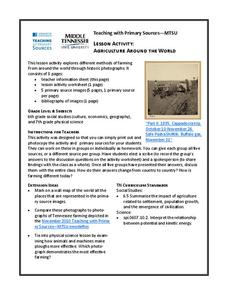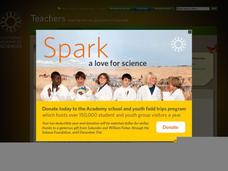University of Minnesota
Welcome To Your Senses
Sound, sight, taste, touch, and smell—oh the world of senses! What do these five senses have to do with the brain? The answer: everything. Explore how the brain sends and receives messages by having the class participate in several sense...
Concord Consortium
The Temperature-Pressure Relationship
Turn up the heat! What happens to the pressure in a closed system as temperature changes? Enhance your chemistry class' understanding of the gas laws with an illustrative interactive. Pupils change the Kelvin temperature before observing...
Royal Society of Chemistry
Electrochromic Polymer—Chemistry Outreach
From windows that tint themselves to OLED technology, electrochromic polymers are redefining our ideas about conducting materials! Introduce your chemistry class to the emerging trend with an exciting lab activity. Budding materials...
Aquarium of the Pacific
Kelp Forest Habitat
What forest is in the ocean? The class watches a video that introduces the kelp forest and the parts of kelp. Learners dive into the ocean and see what different species live near the canopy, the midwater, and the bottom of the kelp...
Bonneville
Introduction to Circuits
Light up the class's knowledge. Pupils build a simple circuit using a battery, wire, and a light bulb and create a diagram of their circuit. The teacher provides a short lecture on a complete circuit, calling attention to the direction...
Bonneville
Unique Solar Cell Engineering Report
Highlight a unique solar cell with a report and a poster. Scholars complete the ongoing solar cells project by writing an engineering report in the last of 14 lessons in the Cost Effective Solar Cells unit. They also create research...
Curated OER
Agriculture Around the World
Students explore various kinds of farming methods around the world. In this history lesson, students view pictures of farming methods, then compare and contrast them in a class discussion with the methods of farming that are used today.
Curated OER
GLOBAL WARMING
Students form definitions of the greenhouse effect based on prior knowledge, class discussion, viewing diagrams, and participate in group brainstorming sessions and class discussions related to the impact of the greenhouse effect and...
Curated OER
Let's Sleep on It
Learners research sleep following a class discussion on an article in The New York Times. Students use their research information to create a health and wellness exhibit that addresses topics related to sleep.
Curated OER
Human Sexuality Presentations
Students examine human health by researching the internet. In this human sexuality instructional activity, students utilize the web to locate a website which contains information about a certain sexual aspect. Students create a group...
Curated OER
Bike-Sharing Catches On
Learners discuss how people are reducing their fuel consumption, then read a news article about a new bike-sharing program in Washington, D.C. In this current events and alternative transportation lesson, the teacher introduces the...
Curated OER
How Trees Contribute to the Water Cycle
In this water cycle instructional activity, 3rd graders conduct an experiment where they observe and calculate how water transpires in different types of trees. Students engage in a class discussion and use Venn Diagrams to compare...
Curated OER
How Do You Measure Up
Students investigate the concept of heart rate and how it is effected by environmental stresses like exercise. They conduct research readings and evaluate the data to form a hypothesis to initiate class discussion about the information.
Curated OER
Environmental Harmony
Students use information from a variety of media to evaluate different artists' views on the human relationship to nature. From these sources, class discussion, and personal experience, students will synthesize a thoughtful,...
Curated OER
Climate Change: Carbon Cycle
Learners explore the carbon cycle. In this carbon cycle lesson, students discuss the four main reservoirs where carbon is stored and then discover the process through which each reservoir absorbs and releases CO2. This lesson includes a...
Curated OER
Drugs
Students explore peer pressure by completing worksheets. In this drug awareness lesson, students define a long list of illegal and prescription drugs while viewing images of each drug. Students complete a word match worksheet and conduct...
PBS
Stories of Painkiller Addiction: Myth or Fact
Are opioids the most abused drug after marijuana? How hard is it for young people to obtain painkillers without a prescription? Middle and high schoolers explore the growing epidemic of opioid addiction with a lesson that prompts them to...
Curated OER
Memorable Ways to Cover the Periodic Table
An exploration of the periodic table can lead to a discussion of the scientific process and the ways that our knowledge of this topic evolves and grows.
Curated OER
The Class Trip
Mrs. Moore's class is trying to earn money for a trip to the science museum, but how much more do they need? Solve this problem with your own class as they develop their ability to model real-life situations algebraically. As an added...
California Academy of Science
What's on a Penny?
As a lesson plan on scientific observation, have your class investigate the features of a penny and a nickel. Working in pairs, they practice writing detailed descriptions using their senses and a ruler to gather information. This is an...
Manitoba Education and Early Childhood Learning
A Foundation for Implementation
Color is the focus of this amazing resource packed with math, social studies, science, and language arts activities. Kids create a color word wall and post symbols, graph the number of objects they find of each color while on a treasure...
California Department of Education
Evaluating Web Sites
If it's on the Internet, it must be true—right? How can someone tell if a website contains less-than-truthful information? Savvy surfers evaluate sources in the fifth of a six-part college and career readiness instructional activity...
Baylor College
Pre-Assessment: The Brain
Break your class in to the general structure and function of the brain. Brainiacs discuss what they know about it and create personalized brain development timelines. They also take a true-false, pre-assessment quiz to get them thinking...
Howard Hughes Medical Institute
The Making of the Fittest: Got Lactase? The Co-evolution of Genes and Culture
Got milk? Only two cultures have had it long enough to develop the tolerance of lactose as an adult. Learn how the responsible genes evolved along with the cultures that have been consuming milk. This rich film is supplied with a few...

























